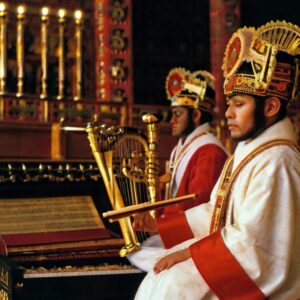Picture this—an elegant wedding set in a grand cathedral, the bride gracefully walking down the aisle to Pachelbel’s “Canon in D.” The sound of a symphony playing as you say goodbye to a loved one at a funeral, with the moving strains of Barber’s “Adagio for Strings.” Isn’t it magical how classical music so seamlessly fits into these moments?
The Emotional Resonance
The impact of classical music on our emotions is profound; it’s as if the melodies and harmonies create a direct line to our souls. This characteristic makes classical music especially powerful during ceremonies and rituals, which are inherently emotional events. These pieces of music have the ability to evoke and amplify deep feelings, creating a rich tapestry of emotional experience. Take, for instance, Handel’s monumental “Hallelujah Chorus” during a Christmas service. The jubilant and majestic sounds heighten the sense of celebration and create a communal experience of awe and reverence. Similarly, consider the serene and ethereal sound of Bach’s “Ave Maria” performed at a baptism. The gentle, flowing melodies provide a sense of tranquility and sanctity, elevating the ceremony to a sacred space that resonates deeply with all present. These compositions do more than provide a backdrop, they infuse the occasion with layers of meaning and emotional depth that might otherwise remain untapped. The precise choice of music can transform an ordinary ceremony into an extraordinary and memorable event, making it a vital component in the fabric of these significant moments in our lives.
Weddings
Weddings, by their very nature, are emotionally charged events filled with moments of joy, love, and deep commitment. Amidst such a significant occasion, classical music provides the perfect backdrop to elevate the overall atmosphere and imbue the celebration with a sense of timeless elegance. The music sets the tone for the entire event, creating an ambiance that lingers in the hearts of guests long after the ceremony has concluded.
Vivaldi’s “Four Seasons” is a quintessential choice for weddings, as its diverse movements can perfectly match the varying moods of the day. As guests gather and the ceremony begins, the lively and spirited melodies can evoke an air of joyous anticipation, capturing the excitement of family and friends. When the bride makes her entrance, the music seamlessly transitions to a more serene and solemn tone, reflecting the gravity and beauty of the moment. During the vows, the gentle harmonies underscore the profound promises being exchanged, enhancing the emotional depth of the ceremony. As the newlyweds are pronounced husband and wife, the jubilant and celebratory notes perfectly encapsulate the joyous exuberance of the occasion.
Isn’t it fascinating how a composition created over 200 years ago continues to resonate so profoundly in our 21st-century celebrations? Vivaldi’s work, with its intricate melodies and emotional richness, transcends time, much like the love and commitment being celebrated. This timeless quality of classical music helps to connect tradition with contemporary romance, creating a bridge between past and present that makes each wedding unique and memorable.
Funerals
The Consoling Power of Classical Music at FuneralsSaying goodbye to someone you love is one of the things you’ll ever have to do. During emotionally charged moments, the solace found in classical music has been a longstanding tradition at funerals. This timeless genre has the unique ability to offer comfort, evoke memories, and provide a sense of closure. Pieces like Gabriel Fauré’s “Requiem” or Johannes Brahms’ “Ein deutsches Requiem” are more than just notes and rhythms. These compositions serve as a soothing balm to the soul, cradling a grieving heart in its most vulnerable state.
Fauré’s “Requiem” is poignant, with its gentle melodies and ethereal atmosphere. The piece is designed to emphasize fear or sorrow and offer a serene and hopeful vision of eternal rest. Its peaceful cadence and tender harmonies create an environment where mourners can reflect on cherished memories and find a sense of inner peace. It captures the essence of a life lived and the hope of a serene afterlife, making it a comforting presence during the solemn occasion.
Brahms’ “Ein deutsches Requiem” is a work deeply rooted in human experience and spirituality. Unlike traditional requiems, Brahms’ composition is not a liturgical mass. Instead, it focuses on themes of humanity, love, and solace, drawing from various Biblical texts. The profound lyrics and powerful orchestration provide a comforting reminder that while death is a part of life, it also brings us closer to a universal human experience. The work is imbued with a sense of compassion and empathy, helping those who are left behind to navigate their grief and mourning.
The solemn chords and heartfelt compositions mirror the complexities of human emotion experienced during times of loss.
In times of sorrow, classical music does more than fill the void with sound. It serves as a steadfast companion, guiding those in mourning through the labyrinth of their emotions. It provides a structure within which can be expressed, memories can be honored, and a communal sense of peace can be cultivated. Through a church organ, or via a recording, the timeless pieces by Fauré and Brahms offer a universal language of comfort, reminding us of the enduring power of music heal and console even in the darkest of times.
Religious Services
Religious ceremonies have long cherished classical music as an integral part of their rituals and traditions. The vast acoustic spaces of churches, temples, and other places of worship transform these compositions into heavenly experiences. The resonance of classical music within these sacred spaces amplifies the sound and heightens the emotional and spiritual impact on the congregation.
The enduring appeal of Gregorian chants. These centuries-old melodies, with their simple yet profound structure, continue to find relevance today. The repetitive, meditative quality of Gregorian chants fosters an atmosphere of deep contemplation and spiritual connection. Each note and phrase is carefully designed to evoke serenity and introspection, guiding the participants into a state of reverent mindfulness.
The compositions of masters like Johann Sebastian Bach and Wolfgang Amadeus Mozart have stood the test of time in the context of religious services. Bach’s “Mass in B Minor” and Mozart’s “Requiem” are exemplary works that elevate the emotional and spiritual tone of ceremonies. Bach’s intricate fugues and harmonies, combined with the profound lyrics, can lead the congregation through a journey of reflection, repentance, and redemption. Similarly, Mozart’s “Requiem” touches on the themes of mortality and divine mercy, resonating deeply with those in attendance.
The pipe organ’s rich and powerful tones can fill the vast spaces of cathedrals and churches, producing a sound that feels almost otherworldly. From the gentle preludes that signal the beginning of a service to the thunderous postludes that mark its conclusion, the organ’s versatility and grandeur make it a staple of liturgical music.
These classical pieces do far more than provide background sound; they create an environment that supports spiritual engagement and reflection. The music aligns with the rhythms of the rituals, if it’s the solemnity of a prayer, the communal singing of hymns, or the introspective moments of meditation. The integration of classical music into religious ceremonies serves to enhance the overall spiritual experience, lifting the soul and fostering a deeper connection with the divine.

